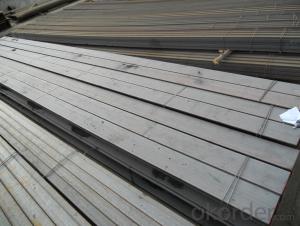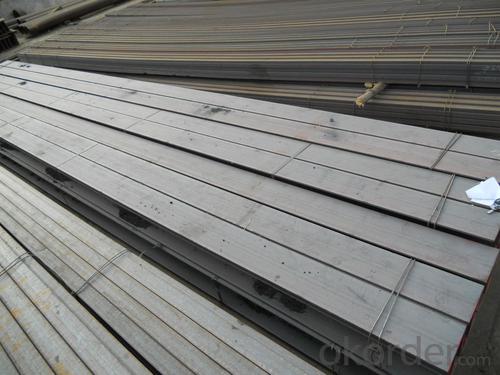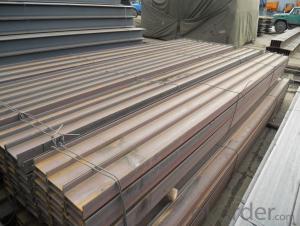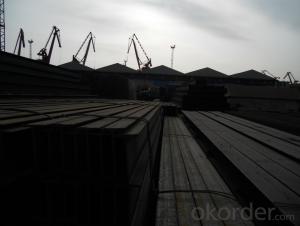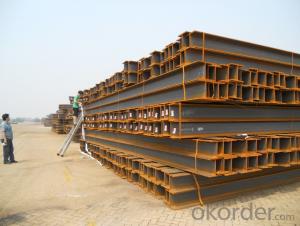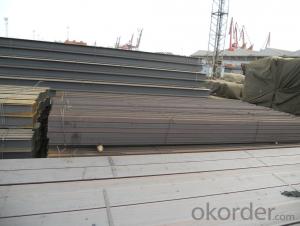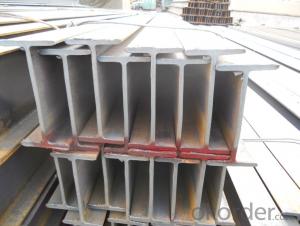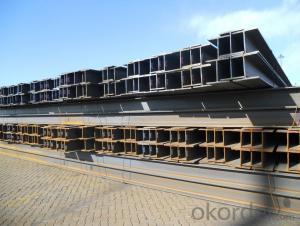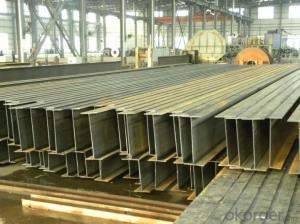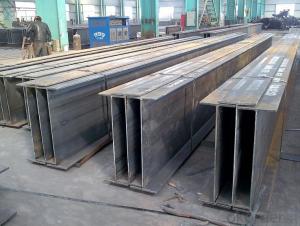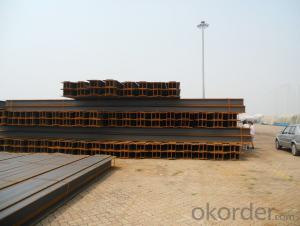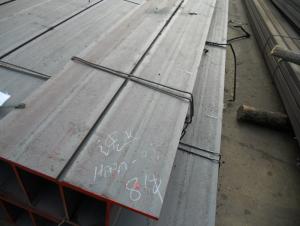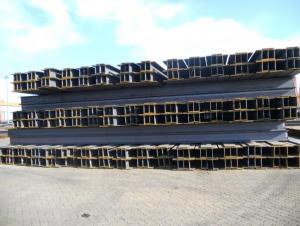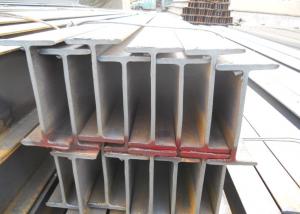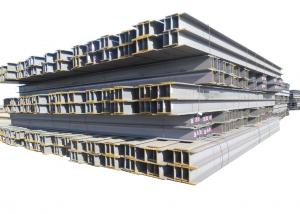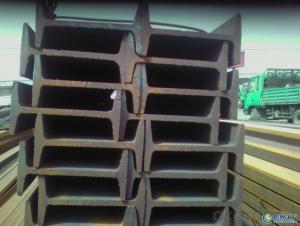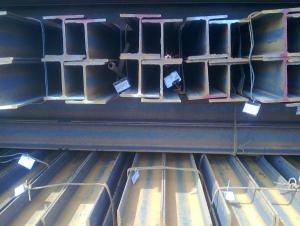Japanese Standard SS400 H beam with High Quality 244mm-250mm
- Loading Port:
- Tianjin
- Payment Terms:
- TT or LC
- Min Order Qty:
- 100 m.t
- Supply Capability:
- 15000 m.t/month
OKorder Service Pledge
OKorder Financial Service
You Might Also Like
Specifications of Japanese Standard SS400 H beam with High Quality 244mm-250mm
1. Standard: JIS 3192
2. Grade: SS400 or Equivalent
3. Length: 10m, 12m as following table
4. Invoicing on theoretical weight or actual weight as customer request
5.Payment: TT or L/C
Size and Mass of Japanese Standard SS400 H beam with High Quality 244mm-250mm:
| Size (mm) | Mass (Kg/m) | Size (mm) | Mass (Kg) |
| 248*124*5.0 | 25.1 | 244*175*7.0 | 43.6 |
| 250*125*6.0 | 20.9 | 250*250*9.0 | 71.8 |
Packaging & Delivery of Japanese Standard SS400 H beam with High Quality 244mm-250mm for Building Structures:
1. Packing: it is nude packed in bundles by steel wire rod
2. Bundle weight: not more than 3.5MT for bulk vessel; less than 3 MT for container load
3. Marks:
Color marking: There will be color marking on both end of the bundle for the cargo delivered by bulk vessel. That makes it easily to distinguish at the destination port.
Tag mark: there will be tag mark tied up on the bundles. The information usually including supplier logo and name, product name, made in China, shipping marks and other information request by the customer.
If loading by container the marking is not needed, but we will prepare it as customer request.
4. Transportation: the goods are delivered by truck from mill to loading port, the maximum quantity can be loaded is around 40MTs by each truck. If the order quantity cannot reach the full truck loaded, the transportation cost per ton will be little higher than full load.
5. Delivered by container or bulk vessel
FAQ:
Q1: Why buy Materials & Equipment from OKorder.com?
A1: All products offered by OKorder.com are carefully selected from China's most reliable manufacturing enterprises. Through its ISO certifications, OKorder.com adheres to the highest standards and a commitment to supply chain safety and customer satisfaction.
Q2: How do we guarantee the quality of our products?
A2: We have established an advanced quality management system which conducts strict quality tests at every step, from raw materials to the final product. At the same time, we provide extensive follow-up service assurances as required.
Q3: How soon can we receive the product after purchase?
A3: Within three days of placing an order, we will arrange production. The shipping date is dependent upon the quatity, how many sizes you want and the plan of production, but is typically 1 month to 2 months days from the beginning of production.
Images of Japanese Standard SS400 H beam with High Quality 244mm-250mm:
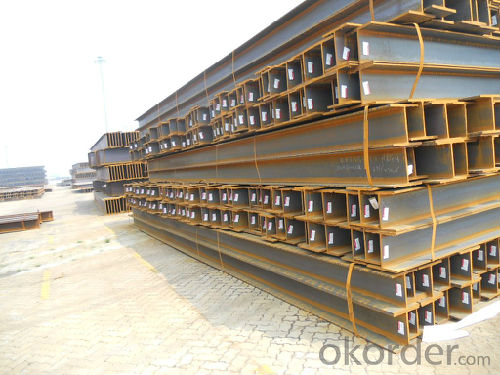
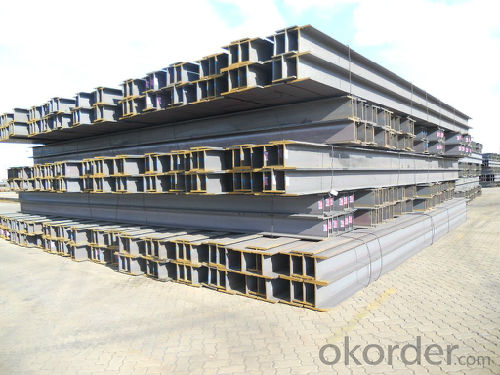
* If you would like to get our price, please inform us the size, standard/material and quantity. Thank you very much for your attention.
- Q: How are steel H-beams installed on construction sites?
- Steel H-beams are commonly used in construction sites for their strength and durability. The installation process of these beams involves several steps to ensure their proper placement and stability. Firstly, the construction site must be prepared for the installation of the steel H-beams. This includes clearing the area of any debris, leveling the ground, and ensuring that the foundation is strong enough to support the weight of the beams. Once the site is prepared, the beams are typically delivered to the construction site in sections. These sections are then lifted into position using cranes or other heavy machinery. The beams are carefully aligned and placed on temporary supports, known as cribbing, to hold them in place during the installation process. Next, the beams are bolted together at the connection points. This ensures that they form a solid and secure structure. Welding may also be used to reinforce the connections and increase their strength. After the beams are connected, they are adjusted into the desired position using hydraulic jacks or other lifting equipment. This ensures that the beams are level and properly aligned with the rest of the structure. Once the beams are in their final position, they are permanently secured to the foundation or supporting structure using bolts or welding. This ensures that they are stable and will not shift or move over time. Finally, the temporary supports, or cribbing, can be removed once the beams are securely in place. This allows for the completion of other construction tasks, such as the installation of flooring or walls. Overall, the installation of steel H-beams on construction sites requires careful planning, coordination, and the use of appropriate machinery. It is important to follow industry guidelines and standards to ensure the structural integrity and safety of the building.
- Q: Can steel H-beams be used in convention center construction?
- Yes, steel H-beams can be used in convention center construction. H-beams are commonly used in construction projects due to their strength, durability, and versatility. They provide structural support and can withstand heavy loads, making them suitable for large-scale buildings like convention centers. Additionally, steel H-beams can be easily fabricated and installed, allowing for efficient construction processes. Their flexibility also enables architects and engineers to design spacious and open layouts, which are often desired in convention centers. Overall, steel H-beams are a popular choice for convention center construction due to their structural integrity, load-bearing capacity, and design adaptability.
- Q: What are the different design considerations for steel H-beams in seismic zones?
- Some of the important design considerations for steel H-beams in seismic zones include the material properties of the steel used, the size and shape of the H-beam, the connections between beams and columns, and the overall structural system used. Additionally, the design must account for the expected seismic forces, including the magnitude and frequency of earthquakes in the specific geographic location. The design should also consider factors such as ductility, stiffness, and energy dissipation capacity to ensure the H-beams can withstand the dynamic forces generated during an earthquake. Finally, proper detailing and construction techniques should be employed to ensure the H-beams are properly anchored and connected to the rest of the structural system, providing adequate resistance against seismic events.
- Q: Can steel H-beams be used for warehouse structures?
- Yes, steel H-beams can be used for warehouse structures. Steel H-beams are widely used in construction due to their strength, durability, and load-bearing capabilities, making them suitable for supporting the weight and maintaining the integrity of a warehouse structure.
- Q: Can steel H-beams be recycled?
- Indeed, steel H-beams can be recycled. Steel, being one of the most recycled materials globally, applies to H-beams made of this material as well. The act of recycling steel H-beams not only aids in lessening the environmental impact associated with mining and manufacturing new steel but also helps conserve energy and resources. The recycling procedure typically involves the collection of H-beams, their subsequent sorting based on their steel grade, and their eventual melting down in a furnace. The resulting molten steel is then utilized in the creation of fresh steel products, which may encompass H-beams or other structural components. By engaging in the recycling of steel H-beams, we can actively contribute to the promotion of a more sustainable and circular economy.
- Q: Can steel H-beams be used in exhibition booth construction?
- Yes, steel H-beams can be used in exhibition booth construction. Steel H-beams are a popular choice for construction due to their strength and durability. They provide a stable and sturdy framework for building structures, including exhibition booths. The H-shape design allows for better load-bearing capabilities, making them suitable for supporting the weight of walls, ceilings, and other elements in an exhibition booth. Additionally, steel H-beams can be easily customized and fabricated to meet specific design requirements and can be painted or coated to enhance their appearance.
- Q: 300*200h steel 7 meter span center load the most, can bearing 30 tons?
- H is the calculation of the height normal stress of the maximum width section of I-beam: Ysigma=M/W, M=, maximum bending moment = load, travel distance, W= bending modulus, maximum allowable stress of Ysigma=, and maximum value of load
- Q: What are the different types of steel used for manufacturing H-beams?
- There are several types of steel commonly used for manufacturing H-beams, including mild steel, carbon steel, and high-strength low-alloy (HSLA) steel. The choice of steel depends on the specific requirements of the application, such as load-bearing capacity, structural strength, and cost-effectiveness.
- Q: How do steel H-beams resist bending and twisting forces?
- Steel H-beams are specifically designed to resist bending and twisting forces due to their unique shape and material properties. The H shape of the beam provides a significant advantage in terms of structural strength and stability. The top and bottom flanges of the H-beam are thicker and wider than the web, which creates a larger surface area to distribute forces. This increased surface area helps to resist bending forces as it can handle more load and distribute it over a larger area. Moreover, the flanges are oriented perpendicular to the web, which further enhances their resistance to bending. In addition to the shape, the material properties of steel contribute to the beam's ability to resist bending and twisting forces. Steel is known for its high strength and stiffness, making it an ideal choice for structural applications. The combination of its strength and ductility allows steel H-beams to withstand considerable loads without permanent deformation. Furthermore, the design of H-beams allows them to efficiently transfer loads and resist twisting forces. The flanges and web work together to create a rigid structure that resists twisting or torsional forces. The web connects the flanges and provides stability, preventing the beam from twisting under applied loads. Overall, the unique shape and material properties of steel H-beams make them highly resistant to bending and twisting forces. Their ability to distribute loads, withstand bending moments, and resist torsional forces makes them a popular choice in various structural applications, such as building frames, bridges, and other load-bearing structures.
- Q: What is the fire rating of steel H-beams?
- Various factors, including beam size, thickness, fire-resistant coatings, and overall fire protection systems, typically influence the fire rating of steel H-beams. Steel is generally recognized as having inherent fire resistance properties when compared to materials like wood. Nevertheless, in high temperatures, steel H-beams can experience thermal expansion and structural deformation, leading to a loss of load-bearing capacity if not supplemented with additional fire protection measures. To enhance the fire resistance of steel H-beams, one can implement fire protection measures such as applying fire-resistant coatings or fireproofing materials to the beam's surface. These coatings or materials are designed to retard heat transfer and delay the steel's critical temperature. The assigned fire rating for steel H-beams depends on the specific fire protection measures employed. Fire ratings are typically expressed in terms of time, such as 30 minutes, 60 minutes, 90 minutes, or 120 minutes, indicating the duration the steel beams can withstand fire exposure without significant structural integrity or load-bearing capacity loss. Determining the appropriate fire rating for steel H-beams in a specific application requires consultation with fire protection engineers, architects, and relevant building codes or standards.
Send your message to us
Japanese Standard SS400 H beam with High Quality 244mm-250mm
- Loading Port:
- Tianjin
- Payment Terms:
- TT or LC
- Min Order Qty:
- 100 m.t
- Supply Capability:
- 15000 m.t/month
OKorder Service Pledge
OKorder Financial Service
Similar products
Hot products
Hot Searches
Related keywords
